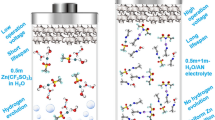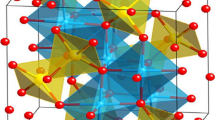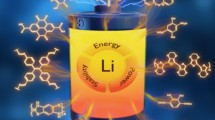Abstract
The intercalation of foreign ions has been demonstrated to be one of the effective methods to improve the electrochemical performance of Ti3C2Tx MXene. However, whether different intercalated ions have diverse impacts on the MXene structure and electrochemical properties is not well understood. Herein, we comprehensively investigated the structural features and electrochemical performances of a series of ions, including Li+, Na+, K+, Cs+, Zn2+, Mg2+, SO42−, and OH− intercalated MXenes. Different ions are observed to exhibit variations in the intercalation effect because of the differences in their sizes, charge numbers, and chemical features. Among the investigated intercalation agents, CsOH composed of monovalent Cs+ with a large size and strong base anion OH− exhibits a superior intercalation effect, where a large interlayer space accommodating a large amount of free water, a high oxidation state of Ti and a preferred surface with more O-containing functional groups for redox reaction is created, intensifying the pseudocapacitive H+ intercalation. Therefore, CsOH-treated MXene exhibits a significant enhancement in gravimetric capacitance (i.e., approximately 725% of the original) and more than 100% capacitance retention over 20,000 cycles. This paper provides a guideline for the rational design and construction of high-capacitance MXene and MXene-based hybrid electrodes in aqueous electrolytes.

摘要
离子插层是提高Ti3C2Tx MXene电化学性能的有效方法之一. 然而, 不同的插层离子对MXene的结构和电化学性能的影响是否相同这一问题尚不清楚. 本文系统研究了Li+、Na+、K+、Cs+、Zn2+、Mg2+、SO42−和OH−等一系列离子插层后的MXene的结构特征和电化学性能. 研究结果表明, 插层离子的半径、电荷数和化学特性对插层效果都会产生影响. 在所研究的插层剂中, 由离子半径最大的一价阳离子Cs+和具有强碱性的阴离子OH−组成的插层剂CsOH对MXene具有较好的插层效果. 插层后的MXene层间距增大, 层间容纳了大量游离水, Ti的价态升高, 片层表面有利于氧化还原反应的含O官能团增多, 这都大大促进了电解液离子H+的扩散与存储. 由此制备的电极的质量比电容大幅度提高, 为原始MXene电极的7倍多, 而且经过20,000次充放电循环后电容保持率未发生下降. 本文为具有高电容性能的MXene和MXene基复合电极的合理设计和制备提供了指导.
Similar content being viewed by others
References
Wang X, Mathis TS, Sun Y, et al. Titanium carbide MXene shows an electrochemical anomaly in water-in-salt electrolytes. ACS Nano, 2021, 15: 15274–15284
Shimada T, Takenaka N, Ando Y, et al. Relationship between electric double-layer structure of MXene electrode and its surface functional groups. Chem Mater, 2022, 34: 2069–2075
Yang Z, Zhang J, Kintner-Meyer MCW, et al. Electrochemical energy storage for green grid. Chem Rev, 2011, 111: 3577–3613
Chen X, Zhu Y, Zhang M, et al. N-butyllithium-treated Ti3C2Tx MXene with excellent pseudocapacitor performance. ACS Nano, 2019, 13: 9449–9456
Lin Z, Goikolea E, Balducci A, et al. Materials for supercapacitors: When Li-ion battery power is not enough. Mater Today, 2018, 21: 419–436
Gui Q, Ba D, Li L, et al. Recent advances in materials and device technologies for aqueous hybrid supercapacitors. Sci China Mater, 2022, 65: 10–31
Fleischmann S, Mitchell JB, Wang R, et al. Pseudocapacitance: From fundamental understanding to high power energy storage materials. Chem Rev, 2020, 120: 6738–6782
Li Z, Dai J, Li Y, et al. Intercalation-deintercalation design in MXenes for high-performance supercapacitors. Nano Res, 2022, 15: 3213–3221
Wang X, Bak SM, Han M, et al. Surface redox pseudocapacitance of partially oxidized titanium carbide MXene in water-in-salt electrolyte. ACS Energy Lett, 2021, 7: 30–35
Okubo M, Sugahara A, Kajiyama S, et al. MXene as a charge storage host. Acc Chem Res, 2018, 51: 591–599
Anasori B, Lukatskaya MR, Gogotsi Y. 2D metal carbides and nitrides (MXenes) for energy storage. Nat Rev Mater, 2017, 2: 16098
Hu M, Zhang H, Hu T, et al. Emerging 2D MXenes for supercapacitors: Status, challenges and prospects. Chem Soc Rev, 2020, 49: 6666–6693
Pang J, Mendes RG, Bachmatiuk A, et al. Applications of 2D MXenes in energy conversion and storage systems. Chem Soc Rev, 2018, 48: 72–133
Tan ZL, Wei JX, Liu Y, et al. V2CTx MXene and its derivatives: Synthesis and recent progress in electrochemical energy storage applications. Rare Met, 2022, 41: 775–797
Wang L, Zhang X, Xu Y, et al. Tetrabutylammonium-intercalated 1TMoS2 nanosheets with expanded interlayer spacing vertically coupled on 2D delaminated MXene for high-performance lithium-ion capacitors. Adv Funct Mater, 2021, 31: 2104286
Wang H, Wu Y, Yuan X, et al. Clay-inspired MXene-based electrochemical devices and photo-electrocatalyst: State-of-the-art progresses and challenges. Adv Mater, 2018, 30: 1704561
Naguib M, Kurtoglu M, Presser V, et al. Two-dimensional nanocrystals produced by exfoliation of Ti3AlC2. Adv Mater, 2011, 23: 4248–4253
Naguib M, Mochalin VN, Barsoum MW, et al. 25th anniversary article: MXenes: A new family of two-dimensional materials. Adv Mater, 2014, 26: 992–1005
Lukatskaya MR, Bak SM, Yu X, et al. Probing the mechanism of high capacitance in 2D titanium carbide using in situ X-ray absorption spectroscopy. Adv Energy Mater, 2015, 5: 1500589
Mu X, Wang D, Du F, et al. Revealing the pseudo-intercalation charge storage mechanism of MXenes in acidic electrolyte. Adv Funct Mater, 2019, 29: 1902953
Li C, Zhang X, Wang K, et al. Accordion-like titanium carbide (MXene) with high crystallinity as fast intercalative anode for high-rate lithiumion capacitors. Chin Chem Lett, 2020, 31: 1009–1013
Li J, Wang H, Xiao X. Intercalation in two-dimensional transition metal carbides and nitrides (MXenes) toward electrochemical capacitor and beyond. Energy Environ Mater, 2020, 3: 306–322
Yi S, Wang L, Zhang X, et al. Cationic intermediates assisted self-assembly two-dimensional Ti3C2T/rGO hybrid nanoflakes for advanced lithium-ion capacitors. Sci Bull, 2021, 66: 914–924
Dall’Agnese Y, Lukatskaya MR, Cook KM, et al. High capacitance of surface-modified 2D titanium carbide in acidic electrolyte. Electrochem Commun, 2014, 48: 118–122
Li J, Yuan X, Lin C, et al. Achieving high pseudocapacitance of 2D titanium carbide (MXene) by cation intercalation and surface modification. Adv Energy Mater, 2017, 7: 1602725
Gao Q, Come J, Naguib M, et al. Synergetic effects of K+ and Mg2+ ion intercalation on the electrochemical and actuation properties of the two-dimensional Ti3C2 MXene. Faraday Discuss, 2017, 199: 393–403
Lukatskaya MR, Mashtalir O, Ren CE, et al. Cation intercalation and high volumetric capacitance of two-dimensional titanium carbide. Science, 2013, 341: 1502–1505
Gao Q, Sun W, Ilani-Kashkouli P, et al. Tracking ion intercalation into layered Ti3C2 MXene films across length scales. Energy Environ Sci, 2020, 13: 2549–2558
Al-Temimy A, Prenger K, Golnak R, et al. Impact of cation intercalation on the electronic structure of Ti3C2Tx MXenes in sulfuric acid. ACS Appl Mater Interfaces, 2020, 12: 15087–15094
Alhabeb M, Maleski K, Anasori B, et al. Guidelines for synthesis and processing of two-dimensional titanium carbide (Ti3C2Tx MXene). Chem Mater, 2017, 29: 7633–7644
Hafner J. Ab-initio simulations of materials using VASP: Density-functional theory and beyond. J Comput Chem, 2008, 29: 2044–2078
Blöchl PE. Projector augmented-wave method. Phys Rev B, 1994, 50: 17953–17979
Perdew JP, Burke K, Ernzerhof M. Generalized gradient approximation made simple. Phys Rev Lett, 1996, 77: 3865–3868
Grimme S. Semiempirical GGA-type density functional constructed with a long-range dispersion correction. J Comput Chem, 2006, 27: 1787–1799
Chao D, Zhou W, Xie F, et al. Roadmap for advanced aqueous batteries: From design of materials to applications. Sci Adv, 2020, 6: 4098
Shpigel N, Levi MD, Sigalov S, et al. Direct assessment of nanoconfined water in 2D Ti3C2 electrode interspaces by a surface acoustic technique. J Am Chem Soc, 2018, 140: 8910–8917
Sugahara A, Ando Y, Kajiyama S, et al. Negative dielectric constant of water confined in nanosheets. Nat Commun, 2019, 10: 850
Li N, Li Y, Zhu X, et al. Theoretical investigation of the structure-property correlation of MXenes as anode materials for alkali metal ion batteries. J Phys Chem C, 2020, 124: 14978–14986
Halim J, Cook KM, Naguib M, et al. X-ray photoelectron spectroscopy of select multi-layered transition metal carbides (MXenes). Appl Surf Sci, 2015, 362: 406–417
Acknowledgements
This work was financially supported by the National Natural Science Foundation of China (52072196, 52002199, 52002200, and 52102106), the Major Basic Research Program of Natural Science Foundation of Shandong Province (ZR2020ZD09), the Natural Science Foundation of Shandong Province (ZR2019BEM042 and ZR2020QE063), the Innovation and Technology Program of Shandong Province (2020KJA004), the Open Project of Chemistry Department of Qingdao University of Science and Technology (QUSTHX201813), the Postdoctoral Innovation Project of Shandong Province (202101020), and Taishan Scholars Program of Shandong Province (ts201511034).
Author information
Authors and Affiliations
Contributions
Author contributions Li Z and Hu M initiated the research; Hu M, Dai J and Chen L performed the experiments; Meng A, Wang L and Li G performed the product characterizations and property tests. Xie H performed the theoretical calculation and analysis. Hu M wrote the paper with support from Li Z. All authors contributed to the general discussion.
Corresponding author
Ethics declarations
Conflict of interest The authors declare that they have no conflict of interest.
Additional information
Supplementary information Supporting data are available in the online version of the paper.
Zhenjiang Li obtained his PhD degree from the Northwest Polytechnic University, China in 2003. He has been a full professor at Qingdao University of Science and Technology, China, since 2004. His current research mainly focuses on the synthesis, properties and mechanism of nanomaterial-based novel electrode materials.
Rights and permissions
About this article
Cite this article
Hu, M., Dai, J., Chen, L. et al. Selectivity for intercalated ions in MXene toward a high-performance capacitive electrode. Sci. China Mater. 66, 974–981 (2023). https://doi.org/10.1007/s40843-022-2243-2
Received:
Accepted:
Published:
Issue Date:
DOI: https://doi.org/10.1007/s40843-022-2243-2




